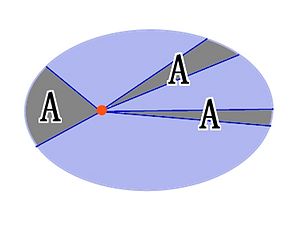Law of Gravitation: Difference between revisions
No edit summary |
No edit summary |
||
| Line 13: | Line 13: | ||
Kepler's Third Law which is also called period law talks about that the ratio of cube of half of the length of the major axis to the square of the orbital period for every planet around the sun is the same. | Kepler's Third Law which is also called period law talks about that the ratio of cube of half of the length of the major axis to the square of the orbital period for every planet around the sun is the same. | ||
<math>\frac{R^3}{T^2}=k \text{ or }\frac{R1^3}{T1^2}=\frac{R2^3}{R2^2} </math> | <math>\frac{R^3}{T^2}=k \text{ or }\frac{R1^3}{T1^2}=\frac{R2^3}{R2^2} </math> | ||
Note that Kepler's Third Law does not only work for planet but also work for satellite. The constant k is only | Note that Kepler's Third Law does not only work for planet but also work for satellite. The constant k is only related to the central celestial body. | ||
===A Mathematical Model=== | ===A Mathematical Model=== | ||
Revision as of 02:02, 4 December 2015
Every two objects in nature attract each other. The magnitude of the attraction force is proportional to the product of the masses of these two objects, and inverse proportional to the square of the distance between these two objects. This page is about Kepler's Three Laws and Law of Gravitation.
Kepler's Three Laws

(1) Kepler's First Law
Kepler's First Law which is also called ellipse orbital law. This law talks about that all the planets that rotate around the sun has a orbital shape of ellipse. Sun is at one focal point of all the ellipse orbitals.
(2) Kepler's Second Law
Kepler's Second Law which is also called area law talks about that the line connected the planet and the sun will swipe the same area at the same period of time.
(3) Kepler's Third Law
Kepler's Third Law which is also called period law talks about that the ratio of cube of half of the length of the major axis to the square of the orbital period for every planet around the sun is the same. [math]\displaystyle{ \frac{R^3}{T^2}=k \text{ or }\frac{R1^3}{T1^2}=\frac{R2^3}{R2^2} }[/math] Note that Kepler's Third Law does not only work for planet but also work for satellite. The constant k is only related to the central celestial body.
A Mathematical Model
What are the mathematical equations that allow us to model this topic. For example [math]\displaystyle{ {\frac{d\vec{p}}{dt}}_{system} = \vec{F}_{net} }[/math] where p is the momentum of the system and F is the net force from the surroundings.
A Computational Model
How do we visualize or predict using this topic. Consider embedding some vpython code here Teach hands-on with GlowScript
Examples
Be sure to show all steps in your solution and include diagrams whenever possible
Simple
Middling
Difficult
Connectedness
- How is this topic connected to something that you are interested in?
- How is it connected to your major?
- Is there an interesting industrial application?
History
Put this idea in historical context. Give the reader the Who, What, When, Where, and Why.
See also
Are there related topics or categories in this wiki resource for the curious reader to explore? How does this topic fit into that context?
Further reading
Books, Articles or other print media on this topic
External links
References
This section contains the the references you used while writing this page